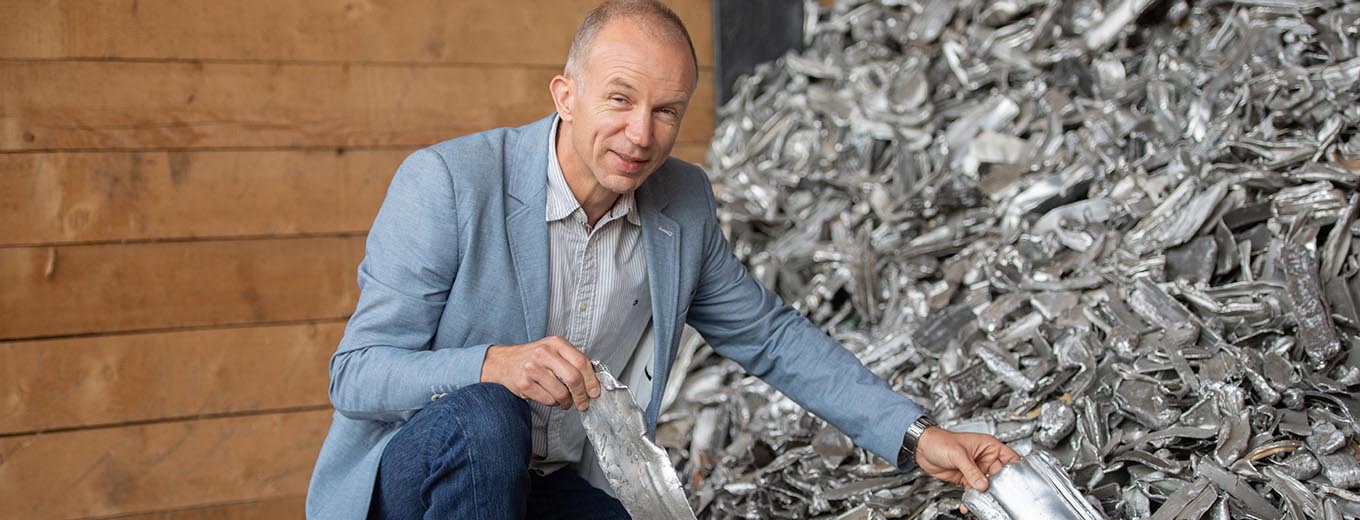A European consortium further develops a Swiss solid-to-energy technology that faces climate change by solving the seasonal energy gap.
This winter has (re)taught us Europeans what it is to freeze. Not because it was particularly cold but because the heaters were turned off in many places due to the rising cost of gas and oil. According to Michel Haller, head of Research at SPF Institute for Solar Technology, an institute from Eastern Switzerland University of Applied Sciences (FH OST), theoretically, to shift away from fossil energy sources, only one thing is missing: long-term energy storage. Haller’s research team developed a new technology to generate energy from aluminium. However, they depend on complementary expertise on how to charge renewable energy into aluminium without CO2 emissions to explore its suitability to store energy in a climate-neutral way. Hence, they partnered up with European colleagues with this expertise, formed a consortium, applied for a Horizon Europe call for research projects and are now elaborating on the idea within the REVEAL project. This multinational collaboration forms the basis to reveal the full potential of aluminium as long-term energy storage.
The potential of this new technology is enormous since, as Michel Haller explains, “the last missing puzzle in our energy system is to close the winter gap with long-term energy storage that is yet to be developed “. This means that we can produce enough green energy in summer, but we cannot yet store it over longer periods such as months and, therefore, cannot use it in winter when we need it most. However, if we cannot solve this issue, we will keep relying on fossil fuels and winter imports, emitting ever more CO2, and staying dependent on others. This exacerbates a much bigger threat than freezing in winter: climate change and political vulnerability. Haller’s primary motivation for his research is to address this very problem: closing the winter gap with renewables, which is also why he worked his entire professional life in renewable energies. And now, he is on the way of developing the last missing puzzle-piece: together with his partners in the REVEAL project, he proposes to use aluminium as a seasonal energy storage vector. But how can aluminium, a material that most of us probably associate more with aluminium foil or cans than with energy, solve the long-term energy storage problem?
Haller explains that his research team first came up with the idea in 2017 when they explored chemical reactions of aluminium and water that produce hydrogen and realised that this could become the base for heat and electricity production at peak-demand times in winter. Building on these findings, a feasibility study was funded by the Swiss Federal Office of Energy (SFOE). Concretely, electricity and heat are produced from the chemical energy stored in the aluminium. Haller and his colleagues were not the first to propose aluminium as energy storage vector. However, while others suggested using aluminium for the energy supply of ships and cars, Haller’s research team focused on using the technology in buildings and for industrial applications that also need heat, not only electricity or motion. Haller explains that “this makes a lot more sense because if you don’t use the heat you gain in the chemical process, it’s kind of a waste of energy. Hence, we focus on applications where both electricity and heat are needed, which is the case in buildings and for industries that need process heat. Especially in buildings, we typically need about ten times more heat than electricity during winter.” So, is it realistic that we will soon be heating our homes with aluminium while also producing electricity? Haller says that, indeed, “people called me this year to ask if we can already deliver our technology since they need it now”, but he had to refuse as the technology still needs improvement to run as an automated system with no or low maintenance and is therefore not yet ready for the market.
However, there is a huge market potential for REVEAL’s technology. Haller explains that it is interesting for “all countries that have the winter problem like Germany, France, Italy or many Eastern European countries”. Furthermore, he identifies four aspects that make the project stand out from other approaches: “first, aluminium has a very high energy density (on a volumetric base even higher than heating oil) and does not need a pressure tank or cooling during storage, making it efficient to store and easy to transport; second, aluminium does not lose any energy after the conversion process in the beginning so that the energy can be stored forever; third, aluminium is not toxic or flammable, which makes the transport and storage much easier; and finally, aluminium is a very abundant raw material, so it is easily available and cheap to produce.”. All this, taken together, leads to an estimated 20 cents per kilowatt hour as the potential end-consumer price for electricity and heat together, including all different steps, like production, transport, and maintenance. In this assumption, the energy costs of the energy-to-solid process are not calculated, as this process would happen in summer when too much energy will be available anyway. Even though this sounds very promising, Haller says that “nothing is final as long as research is ongoing to solve the remaining challenges”.
One of these challenges is the aluminium itself. To receive it in the first place, one can either recycle it from existing aluminium products or produce it directly. While the recycling-based application was already part of a national project funded by the SFOE, the current Horizon Europe project also focuses on the carbon-free production of aluminium. Aluminium can be produced from aluminium oxide by an electrochemical process that consumes electricity (Power-to-X). The traditional electrochemical process was developed partially in Switzerland and used for many years in the canton Valais and at the rhine-falls to produce aluminium. Unfortunately, this process uses carbon electrodes that are consumed during the process and lead to CO2 and other emissions. Therefore, it is not sustainable for a technology that shall be used to fight climate change. Hence, FH OST depends on partners with expertise in climate-neutral aluminium production processes. In Europe, the expertise in this field is exceptionally high in countries that produce much aluminium. Therefore, it was clear to Haller that “we wanted to work with these European partners. So, we contacted them, and later we visited our Icelandic and Norwegian partners, discussed the topic and then agreed to apply for project funding together.”
Following these first discussions, Haller and his team put together a consortium of nine organisations from seven European countries, wrote the application for the Horizon Europe call for Emerging technologies for a climate-neutral Europe and prepared to become REVEAL’s coordinator. However, one month before the call’s opening date, Switzerland got excluded from Horizon Europe, and the consortium had to adapt to the new situation. Haller remembers that “then we kindly asked our Icelandic colleagues if they would take over the coordinator role, and gratefully, they agreed to take over the administrative aspects while we kept the technical lead”. In the end, REVEAL succeeded in the very competitive call, has now been running since July 2022 and will last for a total of 48 months as a co-funded project by the European Union and the Swiss State Secretariate for Education, Research, and Innovation (SERI). Haller experienced the process leading to the co-funding by SERI as very uncomplicated and also is fine with Taeknisetur/IceTec having the lead but is concerned that “Swiss institutions cannot realise their ideas anymore on their own but rely on partners to take over the coordinator role even if the idea and concept are from us and we would be ready to take the lead”.
Haller’s idea was promising enough to overcome these hurdles, and the REVEAL team is even eager to bring the idea out of the lab and establish a spin-off. Haller explains that this was the idea from the beginning, and they “always plainly declared that they want to go to commercialisation with this technology”. Currently, the details are being worked out while each project entity focuses on its research because, as Haller puts it, “in the end, all the paths have to merge for the whole system to work synergistically in the way we have foreseen it”. This will only be possible because of the various European partners involved in the project. At the same time, due to the project’s openness, the potential of aluminium as energy storage spread in Europe and attracted different entities to jump on, which might increase future competition in the market. However, Haller seems unconcerned and explains that “in the end, for climate change, it does not matter if we or others succeed on the market. The main thing is that someone develops this technology up to the level that it can replace the fossil fuels we use now.”. And finally, also prevents us from freezing again in winter.
Picture source: leaderdigital.ch

